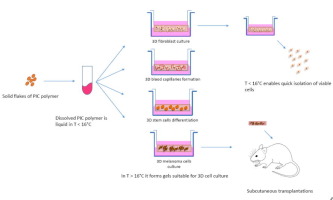Acta Biomaterialia ( IF 9.4 ) Pub Date : 2018-02-15 , DOI: 10.1016/j.actbio.2018.01.042 Jakub Zimoch , Joan Simó Padial , Agnes S. Klar , Queralt Vallmajo-Martin , Martin Meuli , Thomas Biedermann , Christopher J. Wilson , Alan Rowan , Ernst Reichmann

|
Molecular and mechanical interactions with the 3D extracellular matrix are essential for cell functions such as survival, proliferation, migration, and differentiation. Thermo-responsive biomimetic polyisocyanopeptide (PIC) hydrogels are promising new candidates for 3D cell, tissue, and organ cultures. This is a synthetic, thermo-responsive and stress-stiffening material synthesized via polymerization of the corresponding monomers using a nickel perchlorate as a catalyst. It can be tailored to meet various demands of cells by modulating its stiffness and through the decoration of the polymer with short GRGDS peptides using copper free click chemistry. These peptides make the hydrogels biocompatible by mimicking the binding sites of certain integrins.
This study focuses on the optimization of the PIC polymer properties for efficient cell, tissue and organ development. Screening for the optimal stiffness of the hydrogel and the ideal concentration of the GRGDS ligand conjugated with the polymer, enabled cell proliferation, migration and differentiation of various primary cell types of human origin. We demonstrate that fibroblasts, endothelial cells, adipose-derived stem cells and melanoma cells, do survive, thrive and differentiate in optimized PIC hydrogels. Importantly, these hydrogels support the spontaneous formation of complex structures like blood capillaries in vitro. Additionally, we utilized the thermo-responsive properties of the hydrogels for a rapid and gentle recovery of viable cells. Finally, we show that organotypic structures of human origin grown in PIC hydrogels can be successfully transplanted subcutaneously onto immune-compromised rats, on which they survive and integrate into the surrounding tissue.
Statement of Significance
Molecular and mechanical interactions with the surrounding environment are essential for cell functions. Although 2D culture systems greatly contributed to our understanding of complex biological phenomena, they cannot substitute for crucial interaction that take place in 3D. 3D culture systems aim to overcome limitations of the 2D cultures and answer new questions about cell functions.
Thermo-responsive biomimetic polyisocyanopeptide (PIC) hydrogels are promising new candidates for 3D cell, tissue, and organ cultures. They are synthetic and can be tailor to meet certain experimental demands. Additionally, they are characterized by strain-stiffening, a feature crucial for cell behaviour, but rare in hydrogels. Their thermos-responsive properties enable quick recovery of the cells by a simple procedure of lowering the temperature.
中文翻译:

聚异氰肽水凝胶:一种新型的热响应水凝胶,支持血管生成前和器官型结构的发展
与3D细胞外基质的分子和机械相互作用对于细胞功能(例如生存,增殖,迁移和分化)至关重要。热响应仿生聚异氰肽(PIC)水凝胶有望成为3D细胞,组织和器官培养的新候选者。这是一种合成的,热响应性和应力增强的材料,它是通过使用高氯酸镍作为催化剂,通过聚合相应的单体而合成的。可以通过调节其刚度以及通过使用无铜咔嗒化学法用短GRGDS肽修饰聚合物来满足细胞的各种需求。这些肽通过模仿某些整联蛋白的结合位点使水凝胶具有生物相容性。
这项研究致力于优化PIC聚合物的性能,以实现有效的细胞,组织和器官发育。筛选水凝胶的最佳刚度和与聚合物偶联的GRGDS配体的理想浓度,可以使细胞增殖,迁移和人类各种原代细胞类型分化。我们证明成纤维细胞,内皮细胞,脂肪干细胞和黑色素瘤细胞,确实生存,蓬勃发展和分化的优化PIC水凝胶中。重要的是,这些水凝胶可在体外支持复杂结构(例如毛细血管)的自发形成。此外,我们利用水凝胶的热响应特性,快速,温和地恢复了活细胞。最后,我们表明在PIC水凝胶中生长的人类起源器官型结构可以成功地皮下移植到免疫功能低下的大鼠上,在其上存活并整合到周围组织中。
重要声明
与周围环境的分子和机械相互作用对于细胞功能至关重要。尽管2D文化系统大大有助于我们对复杂的生物现象的理解,但它们不能替代3D中发生的关键交互作用。3D培养系统旨在克服2D培养的局限性,并回答有关细胞功能的新问题。
热响应仿生聚异氰肽(PIC)水凝胶有望成为3D细胞,组织和器官培养的新候选者。它们是合成材料,可以定制以满足某些实验要求。此外,它们的特点是应变增强,这是细胞行为的关键特征,但在水凝胶中很少见。它们具有热响应特性,可通过简单的降低温度程序快速恢复细胞。











































 京公网安备 11010802027423号
京公网安备 11010802027423号